Orania, Northern Cape
Orania (Afrikaans pronunciation: [ʊəˈrɑːnia]) is a semi-autonomous[3] Afrikaner town in the middle of South Africa. It is located along the Orange River, in the Karoo region of the Northern Cape province.[4] The town is split in two halves by the R369 road, and is 871 km from Cape Town and 680 km from Pretoria.[5][6]
Orania | |
|---|---|
 Aerial view of the town of Orania | |
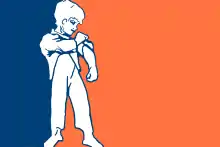 Flag | |
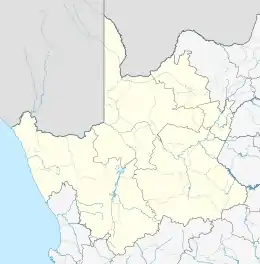 Orania 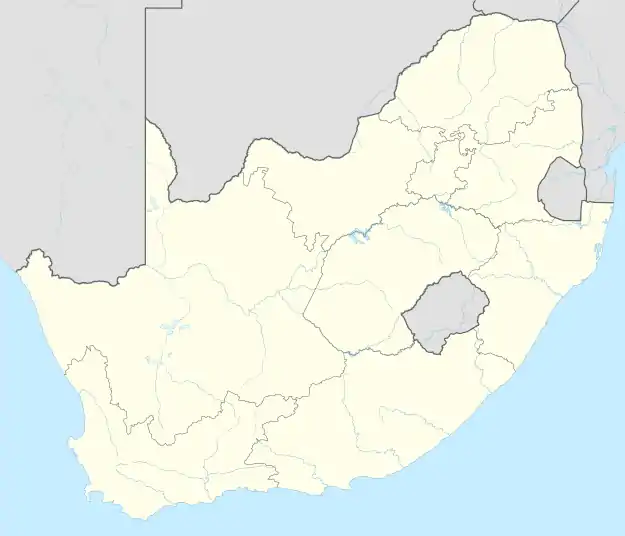 Orania 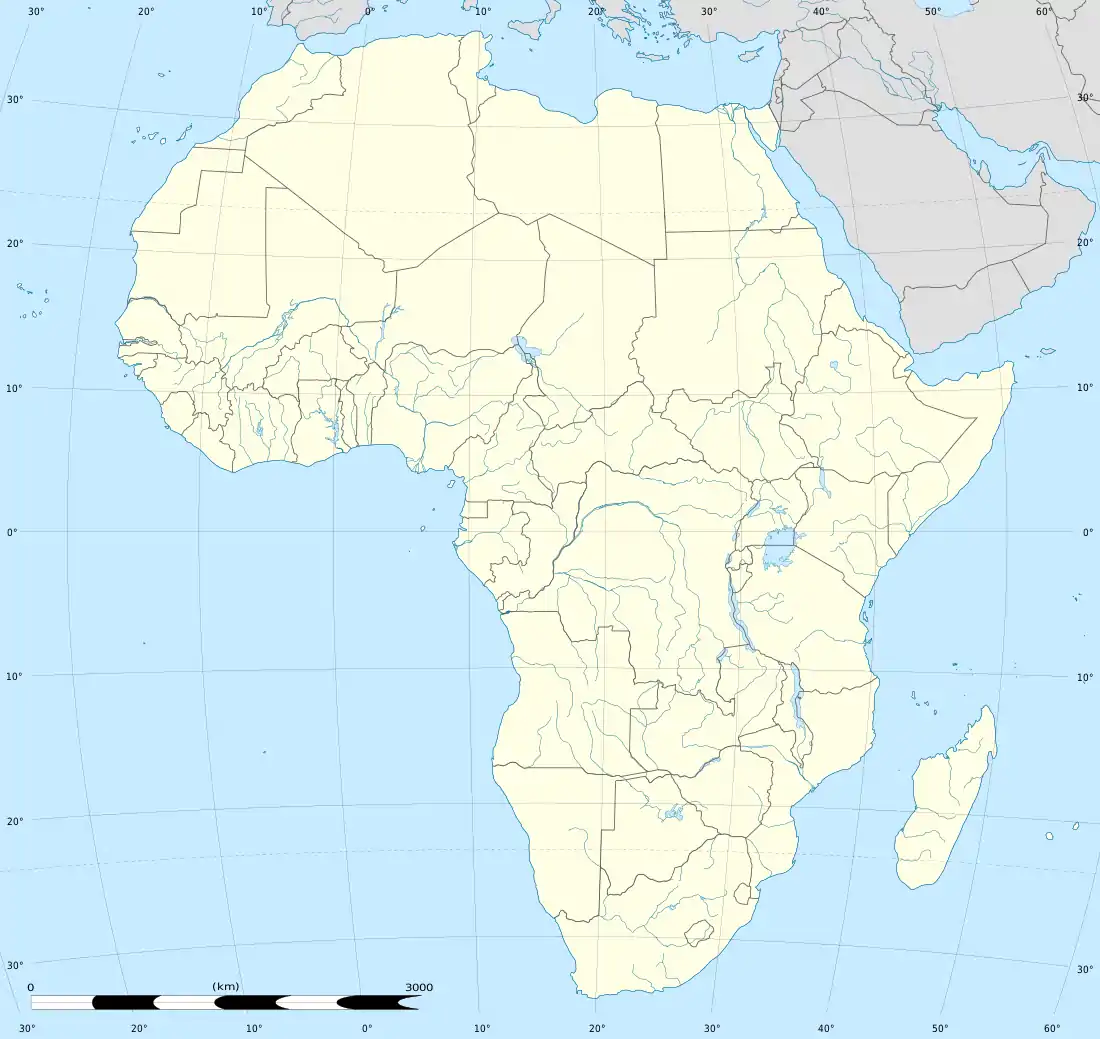 Orania | |
| Coordinates: 29°49′S 24°24′E | |
| Country | South Africa |
| Province | Northern Cape |
| District | Pixley ka Seme |
| Municipality | Orania |
| Established | 1963 |
| Named for | Orange River |
| Government | |
| • Type | Representative council |
| Area | |
| • Total | 8.95 km2 (3.46 sq mi) |
| Elevation | 1,180 m (3,870 ft) |
| Population (2019)[2] | |
| • Total | 1,773 |
| • Density | 200/km2 (510/sq mi) |
| Racial makeup (2011) | |
| • White | 97.20% |
| • Coloured | 1.90% |
| • Black African | 0.90% |
| First languages (2011) | |
| • Afrikaans | 98.4% |
| • English | 1.6% |
| Time zone | UTC+2 (SAST) |
| Postal code (street) | 8752 |
| PO box | 8752 |
| Area code | 053 |
| Website | www |
The stated aim of the town is to create a stronghold for Afrikaners, the Afrikaans language and the Afrikaner culture. The town residents state that anyone who defines themselves as an Afrikaner, and identifies with Afrikaner ethnicity/culture is welcome to live in Orania.[7]
Critics accuse the town authorities of rejecting the Rainbow Nation concept[8] and trying to recreate Apartheid South Africa within a White ethnostate.[9] Proponents contend the desire to preserve their Afrikaner linguistic and cultural heritage, protect themselves from high crime levels, and the right to self-determination, as their main motivation.[10][11] They also reject the "white" label as a meaningless,[12][13][14] and rather identify as 3rd Afrikaners.[15][16]
The town's existence is protected by the Constitution of South Africa through a clause that ensures the right to self-determination. Article 235 of the constitution states the following:
“The right of the South African people as a whole to self determination, as manifested in this Constitution, does not preclude, within the framework of this right, recognition of the notion of the right of self-determination of any community sharing a common cultural and language heritage; within a territorial entity in the Republic or in any other way, determined by national legislation.”
This clause was negotiated when the constitution was first established in 1994, to reassure those worried about the transition to Black majority rule, and was the result of an accord [17] signed between the Freedom Front, National Party and the ANC.
The town's relations with the South African government are non-confrontational, and although opposed to the aspirations of the community,[18] it has recognised them as legitimate.[19]
Ideology and purpose

According to its founders, the purpose of Orania is to create a town where the preservation of Afrikanerdom's cultural heritage is strictly observed and Afrikaner selfwerksaamheid ("self reliance") is an actual practice, not just an idea.[20] All jobs, from management to manual labour, are filled only by Afrikaners; non-Afrikaner workers are not permitted to work unless they have skills no resident has.[21]
Newcomers often say their desire to escape the violent crime prevalent in the rest of the country motivated their decision to move to Orania,[22] and many had been victims of crimes before,[4] while Orania residents claim the town is a secure environment and they have no need to lock their doors.[23][24]
Origins
The quest for self determination has been a common thread throughout Afrikaner history. From casting off the British colonial yoke with abandonement of their homes in the Cape Colony and undertaking the Great Trek in 1837, then again refusing[25] to live under English rule and the abandonment of the Natalia Republic, establishment of the various other Boer Republics, the First Boer War and the Second Boer War against the British, the relentless fight of the Bittereinder, the 1914 Maritz rebellion and the policy of Separate Development, all indicate a strong drive for self determination.
The idea that Afrikaners should concentrate in a limited region of South Africa was first circulated by the South African Bureau for Racial Affairs (SABRA) in 1966.[26][27] By the 1970s, SABRA advocated the idea of transforming South Africa into a commonwealth, where different population groups would develop parallel to each other.[27] At the time, mainstream Afrikaners supported the bantustan policy, which allocated 174,307 sq km (a little bit larger than the US state of Florida) for the 15 million black Africans [28] living in South Africa at the time. Also see, different black Ethnic groups in South Africa.[29]
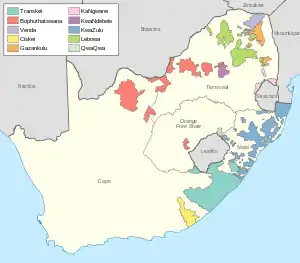
May 1984 saw the establishment of the Afrikaner Volkswag, an organisation founded by Carel Boshoff, a right-wing academic, to put the ideas of the SABRA into practice.[27] Boshoff regarded contemporary plans of the National Party government to retain control through limited reforms as doomed to fail.[30] Believing that black-majority rule could not be avoided, he supported the creation of a separate, smaller state for the Afrikaner nation instead.[30]
In 1988 Boshoff founded the Afrikaner-Vryheidstigting (Afrikaner Freedom Foundation) or Avstig.[27] The founding principles of the Avstig were based on the belief that since black majority rule was unavoidable, and European minority rule morally unjustifiable, Afrikaners would have to form their own nation, or volkstaat, in a smaller part of South Africa.[31] Orania was intended to be the basis of the volkstaat, which would come into existence once a large number of Afrikaners moved to Orania and other such 'growth points',[31] and would eventually include the towns of Prieska, Britstown, Carnarvon, Williston and Calvinia, reaching the west coast.[32]
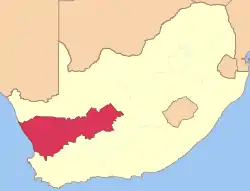
Boshoff's plans excluded the area of traditional Boer republics in the Transvaal and the Free State, which encompass the economic heartland of South Africa and much of its natural resources, instead focusing on an economically underdeveloped and semi-desert area in the north-western Cape.[34][31] This desert state, Orandeë, because of its very inhospitableness would not be feared or coveted by the South African government.[35]
Proponents of the idea conceded that this model would demand significant economic sacrifices from Afrikaners who moved to the volkstaat.[31] The model is based on the principle of 'own labour', requiring that all work in the volkstaat be performed by its citizens, including ploughing fields, collecting garbage and tending gardens, which is traditionally performed by blacks in the rest of South Africa.[20][36]
The town's original objective was to create an Afrikaner majority in the northwestern Cape, by encouraging the construction of other such towns, with the eventual goal of an Afrikaner majority in the area and an independent Afrikaner state between Orania and the west coast. [34] Boshoff had originally envisaged a population of 60,000 after 15 years.[37] While he conceded that most Afrikaners might decide not to move to the volkstaat, he thought that it was essential Afrikaners have this option, since it would make them feel more secure, thereby reducing tensions in the rest of South Africa.[31]
Evolution of Orania Concept
A policy shift was announced in 2014. Acknowledging that early growth expectations had not been met, the town's chief executive argued that Orania should employ its limited resources to grow into a 'city' of around 50,000 inhabitants. Urbanisation was deemed necessary to strengthen cultural institutions, deliver services and make possible an adequate standard of living for residents.[38] However, the ultimate objective remains self-determination,[38] similar to the countries of Lesotho and Eswatini, which are also situated inside South Africa.
Carel Boshoff IV rejected the word volkstaat, arguing that repeated use with no grounding in reality had led it to become an abstract term.[39] While regarding an Afrikaner nation as desirable, he felt the word carried too much baggage, connected to unrealistic and anachronistic expectations.[39] The vision of an Afrikanerstad was seen as a more effective way to achieve prosperity and decision-making power.[40] The shift met with some resistance, as the Orania Movement was seen as straying away from its original goal.[41] The movement since then promotes Orania as the "Home of the Afrikaner" (Afrikanertuiste)[42]
External reception
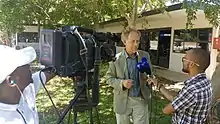
The community receives numerous visits from local and international media organisations,[43] and Oranians are constantly in contact with journalists.[44] The existence of Orania as a homogeneously Afrikaner town is controversial, with most progressive [45] reporters hostile to the idea of Monoculturalism;[46][47] and thus portray Orania as a culturally backward, racially intolerant,[48] and separatist place.[49]
In 1991 the New York Times said that Orania was a "ghost town where white supremacists dream of carving out an idyllic homeland".[50] In 1994 the Los Angeles Times described it as a "Zealots’ Dream" and "a bastion of intolerance".[51] A year later the Chicago Tribune saw it as "the last pathetic holdout of the former ruling class of South Africa", continuing that "the Afrikaners who once forced blacks to live apart from the rest of society are now living in their own prison".[52] Bill Keller dubbed Orania "the racist Camelot".[53] A Mail & Guardian article describes it as a "widely ridiculed town" and a "media byword for racism and irredentism".[54] An article in The Independent similarly writes that residents of Orania "have a reputation for being racists, and that the town attracts plenty of negative press".[55] Benjamin Pogrund described Orania as a "curious hangover from the vanished terrible past".[56] Vadim Nikitin from The National News, noted that Orania was South Africa's last bastion of apartheid, and a "pathetic outpost of embittered racists", refusing to live in equality with black South Africans, and also a 1950s-style fantasy shielding locals from declining white privilege.[57]
Orania was deemed to lack privilege, however, as residents have no domestic workers and few material luxuries; white suburbs in the rest of South Africa, with their high levels of segregation and heavy use of domestic labour, were felt to more closely resemble the apartheid era than Orania did.[57] Along similar lines, Orania was also seen as "one of the few places in South Africa... where class is not determined by skin colour".[58] Eve Fairbanks, former staff writer for The New Republic, sees Orania as an attempt to show that Afrikaner culture can be redeemed from its traditional exploitation of black labour.[59] Another journalist found comparisons of Orania to the apartheid system inappropriate, as town authorities do not seek to exploit or subjugate blacks, but simply demand separation.[60] In its obituary of Orania's founder Carel Boshoff, Foreign Policy magazine agreed with Boshoff's proposition that the position of European South Africans as a privileged class dependent on black labour is untenable.[61] The executive director of the South African Free Market Foundation, Leon Louw, has also written an article questioning the perception that the town is a refuge for racial bigots.[62]
Orania is mentioned in one of the leaked American diplomatic cables, relating details of a 2004 visit to the town, where it is described as a "sleepy country town with few signs of growth or vitality".[63] A sentiment shared by Gavin Haynes from Vice News who said that, "If you're a certain way inclined, Orania is probably a nice place to live. It's very neighbourly. It's also one of the dullest, most achingly pointless places in Christendom".[64]
Professor Kwandiwe Kondlo, a professor in Political Economy at the University of Johannesburg, said that Orania served as an important safety valve for Afrikaners in transition, and that “The Afrikaners are very forward-thinking people. Orania was established as a tactical strategic exit for the Afrikaner, should the new South Africa run into serious crisis. They will then have a place to preserve themselves,”.[65]
Rebecca Davis of the Daily Maverick feels that, "What makes Orania different is that it makes no secret of its discrimination. Because of this, the town has come to occupy a place in the public imagination vastly out of proportion to its size".[66]
Andrew Kenny, of the The Citizen newspaper, wrote that, "Orania was a revelation to me. I was enormously impressed by its success, decency, safety, modesty, friendliness, cleanliness, by its spirit of goodwill, by its egalitarian attitudes and, above all, by its prevailing philosophy of freedom".[67]
Afrikaner reception
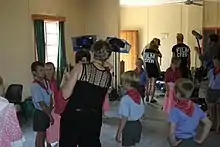
Most Afrikaners did not support the establishment of an Afrikaner state,[60] as they saw it as nothing more than an impractical pipe dream.[68] Shortly after the first residents moved in in 1991, many Afrikaners derided the project as unrealistic,[69] with even right-wingers rejecting it for its location in barren territory, far from traditional Afrikaner states.[70] Two decades later, a survey of Beeld readers (in 2010), found that 56% of respondents would consider moving to a volkstaat.[71]
The largest right-wing party in apartheid-era South Africa, the Conservative Party, did not support the volkstaat concept until 1993, shortly before converging with other right-wing organisations into the Afrikaner Volksfront.[72] Even then, their plan involved separating parts of Transvaal Province, including Pretoria, to form a state where the many black residents would have only limited voting rights.[72] Negotiations to this end were conducted with the African National Congress, but were inconclusive.[73]
Orania and its leadership are poorly regarded by the Afrikaner far-right, as their official stance of opposing racism is said to be seen as excessively liberal.[74]
In 2010 Marida Fitzpatrick, journalist for the Afrikaans newspaper Die Burger, praised the town for its safety and environmentally friendly approaches to living, but also wrote that overt racist ideas and ideology still underpinned the views of many residents.[75] Members of the AfriForum group who visited Orania in February 2015 came back with mostly positive impressions of the town, comparing it to a Clarens or Dullstroom of the Karoo.[76] Afrikaans singer Steyn Fourie is a supporter of Orania,[77] and wrote a song about the town.[78]
In 2018, Afrikaans trade union, Solidariteit, and AfriForum named Orania as one of their 30 “anchor towns”[79] to which Afrikaner migration should be encouraged.[80] With the aim of becoming the majority population in these areas, making self determination possible. Frustrated by Corruption in South Africa,[81][82][83] government's underperformance [84] and perceived racism[85][86] of the ANC government, Solidariteit launched its, "Ons Sal Self" (We will do it ourselves) campaign in October 2020. Supposedly the largest Afrikaner mobilization effort in 118 years.[87] The aim being to circumvent government and provide education, training and social services for Afrikaans communities.[88] Solidarity has been accused of trying to create a parallel state in South Africa.[89]
By 2020, as the perception grew that South Africa was approaching failed state status,[90][91][92][93][94] the idea of Afrikaner self determination was again gaining popularity. In October 2020, the Freedom Front held a series of conferences[95] on Afrikaner self determination with speakers: Prof. Koos Malan, Flip Buys, Prof. Deon Geldenhuys, Dr. Pieter Mulder, Dawie Roodt, Dr. Corne Mulder as well as speakers from Orania (Carel Boshoff, Dr. Wynand Boshoff and Frans de Klerk). Concluding that the government cannot provide in the needs of Afrikaners, and that different forms of self determination must be pursued.[96]
History
Early history

The Orania region has been inhabited since about 30,000 years ago when Stone Age hunter-gatherers lived a nomadic lifestyle there.[97] A number of late Stone Age engravings indicate the presence of the San people, who remained the main cultural group until the second half of the 1700s, with the arrival of European hunters, trekkers and the Griqua people.[97] The earliest indication of the presence of Afrikaner people in Orania dates to 1762, and in the early 19th century many farmers moved seasonally back and forth across the Orange River in search of better grazing.[97] An 1842 Rawstone map shows the Vluytjeskraal farm,[97] on which Orania would later be built.[27] The first known inhabitant of what is today Orania was Stephanus Ockert Vermeulen, who purchased the farm in 1882.[98][99]
The Department of Water Affairs established the town as Vluytjeskraal in 1963 to house the workers who were building the irrigation canals connected to the Vanderkloof Dam.[100][101] It was part of a bigger scheme to bring water to the semi-desert central parts of South Africa. Other comparable construction towns like Vanderkloof and Oviston were also established. Its name was changed to Orania, a variation of the Afrikaans word oranje, referring to the adjoining river,[48] after it was chosen in a competition.[102] By 1965 it was home to 56 families.[102] Coloured workers who participated in the construction project lived in a separate area named Grootgewaagd.[103] The first phase of the project was completed in 1976.[103] After the dam was completed most of the workers moved away, and the town fell into disrepair.[101] The department completely abandoned Orania in 1989,[104] though a group of coloured people continued to live in Grootgewaagd.[103]
Establishment & Recognition
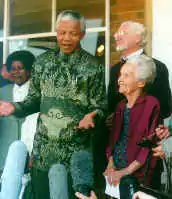
| External video | |
|---|---|
In December 1990, about 40 Afrikaner families, headed by Carel Boshoff, the son-in-law of former South African Prime Minister Hendrik Verwoerd, bought the dilapidated town for around R1.5 million (US$585,000),[37][lower-alpha 1] on behalf of the Orania Bestuursdienste (OBD).[105] The first 13 inhabitants moved in in April 1991.[106] During the same month, the people who still lived in Grootgewaagd were evicted,[107] after being provided with newly built homes in nearby towns.[108] The village was renamed Kleingeluk.[109]
The National Party government led by F. W. de Klerk opposed the creation of an Afrikaner state, and the existence of Orania, but it took no action, believing it would fail on its own.[110] At that time, the town consisted of 90 houses in Orania and 60 in Kleingeluk, all in a grave state of disrepair.[109] In August 1991 the 2,300-hectare (5,700-acre) farm Vluytjeskraal 272 was added to Orania.[111][112]
The presence of residents with politically extreme views hampered early attempts to gain broader acceptance for the community.[113] Afrikaner Weerstandsbeweging (AWB) members made up a sizable minority of the population.[114] In July 1991, one resident publicly threatened to resort to terrorism unless Orania was granted independence.[115] By 1993, people with similarly militant views had reportedly been removed from the community.[116] Yet, some black people from neighbouring communities feel that they are not welcome to visit the town, to buy in local shops or to use petrol stations.[117]
The town council was established in February 1992.[118] A journalist for the Provinciale Zeeuwse Courant, visiting in 1993, noted that houses had been repaired, but the town lacked any meaningful economic activity.[114] There were few jobs available, and no money for further development.[114] The town relied on neighboring farms for food.[119]
Orania elected its own transitional representative council, a temporary form of local government created after the end of apartheid, in 1995.[120] Construction on an irrigation scheme to cover a 400-hectare (990-acre) area began in 1995 and was completed in October 1996.[121]

In a conciliatory gesture, then-President Nelson Mandela visited the town in 1995 to have tea with Betsie Verwoerd, widow of former Prime Minister Hendrik Verwoerd.[122] Orania grew to 200 permanent inhabitants in 1996.[106] By 1998 R15 million had been invested in the town for expenses including the upgrading of water and electricity supply, roads and businesses.[123]
On 5 June 1998, Valli Moosa, then Minister of Constitutional Development in the African National Congress (ANC) government, stated in a parliamentary budget debate that "the ideal of some Afrikaners to develop the North Western Cape as a home for the Afrikaner culture and language within the framework of the Constitution and the Charter of Human Rights is viewed by the government as a legitimate ideal".[124][19]
On 14 Sept 2010, the president of South Africa, Jacob Zuma visited Orania. He said that he was "warmly welcomed", that Orania had “interesting ideas”, and, "the Oraniers were prepared to live in South Africa, but wanted a place to exercise their culture".[125][126]
In August of 2018, the Orania movement met with the previous president, Mr Thabo Mbeki, as part of their public relations efforts.[127] Stating that, “If someone is not your friend, he does not necessarily have to be your enemy. Put differently: neutralize enemies wherever you can. Make friends wherever possible. Someone like Mr Mbeki has no power but he has influence”. Mr. Mbeki is also credited with advising the Orania movement to, "Create facts on the ground, and then confront government with a reality which they cannot resist".[128]
Legal Actions and Threats
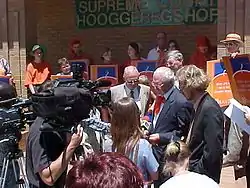
In December 2000, the provincial government ordered the dissolution of Orania's town council and its absorption into a new municipality along with neighbouring towns.[129][130][131] Oranians lodged an application with the Northern Cape Division, which found that negotiations between the residents of Orania and the government for a compromise on Orania's municipal status should take place;[132] until such an agreement can be reached, the status quo would remain.[133]
In May 2005, a dispute arose with a faction of residents who claimed the town was being run like a 'mafia', with a number of lawsuits being filed as part of the dispute.[134] A raid on the town's radio station in November 2005 was linked to a tip-off received from internal dissenters;[43] they ultimately left the community.[135]
In November 2005, around 20 coloured families who lived in Kleingeluk before 1991 lodged a land claim with the government for around 483 hectares (1,190 acres) of land within Orania.[136] It was settled in December 2006 when the South African government agreed to pay the claimants R2.9 million in compensation.[137]

In 2016, prior to the 2016 local elections, the Thembelihle branch of the Economic Freedom Fighters (EFF) campaigned on a platform to end the autonomous status of Orania, if elected to govern the municipality. Saying that its autonomy would no longer be tolerated in an EFF run municipality.[138] After a visit to Orania, Thembelihle's EFF mayor, Danny Jonas, said he wanted to retain the status quo while working together with Orania for the benefit of Thembelihle.[139] In 2009 the EFF's leader, Julius Malema visited Orania.[140] In 2019, Mr. Malema indicated that he agreed with the idea of moving landless black people to Orania.[141]
In June 2020, Gauteng ANC MEC for education, Panyaza Lesufi,[142][143] said that Orania had to fall as it is neither a symbol of inclusivity nor democracy. “We understand why that institution was established. It has lived its time now. It’s now that that place must be liberated and all South Africans must be allowed to stay wherever they want to stay".[144] He also said, "If you think we will keep quiet you are wrong. This madness must come to an end. It’s a betrayal of our call for a truly non-racial SA”.[145] In response ANC veteran Carl Niehaus said, “Destroy the money, destroy the damn flag. Charge these white, Orania ‘Boere’, for their racism, throw them in jail”.
In January 2021, the Orania Movement made a Facebook post about how Afrikaners should develop their own sport institutions in view of government controlled sports organisations hostile to Afrikaners.[146][147][148][149] Facebook removed[150] this post as hate speech, which is in line with their new policy of "banning praise or support for white separatism" from their platform.[151] In response the Orania movement created a channel on Telegram.
Geography
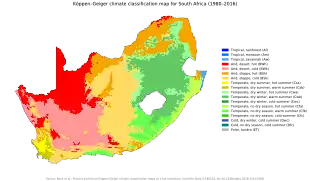
The area around the town is semi-arid.[152] Orania is part of the Nama Karoo biome, and receives 200–250 millimetres (7.9–9.8 in) of rain a year.[153] More than 30,000 trees have been planted in Orania and the surrounding farmlands.[154] Prospective residents are warned of the inclement weather conditions, with extreme temperature differences between summer and winter.[155]
The vegetation of Orania includes karee and witkaree trees, blinkblaar-wag-’n-bietjie, witgat and Sweet thorn trees.[156]
Climate
| Month | Jan | Feb | Mar | Apr | May | Jun | Jul | Aug | Sep | Oct | Nov | Dec | Year |
|---|---|---|---|---|---|---|---|---|---|---|---|---|---|
| Average high °C (°F) | 34.3 (93.7) |
34.1 (93.4) |
30.6 (87.1) |
26.2 (79.2) |
22.7 (72.9) |
17.7 (63.9) |
18.9 (66.0) |
23 (73) |
28.2 (82.8) |
27.2 (81.0) |
30.1 (86.2) |
31.7 (89.1) |
27.1 (80.7) |
| Average low °C (°F) | 17.9 (64.2) |
16.7 (62.1) |
14.4 (57.9) |
12.5 (54.5) |
3.8 (38.8) |
3.4 (38.1) |
1.5 (34.7) |
4.2 (39.6) |
9.9 (49.8) |
12.1 (53.8) |
13.4 (56.1) |
17.1 (62.8) |
10.6 (51.0) |
| Average rainfall mm (inches) | 65 (2.6) |
5 (0.2) |
30 (1.2) |
26 (1.0) |
0 (0) |
0 (0) |
0 (0) |
0 (0) |
0 (0) |
0 (0) |
0 (0) |
129 (5.1) |
255 (10.1) |
| Source: [153] | |||||||||||||
Subdivisions and architecture
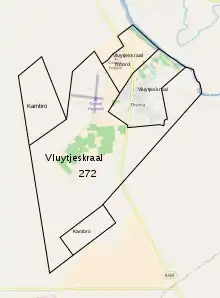
Orania has three residential areas: Kleingeluk ("small happiness"), Grootdorp ("big village") and Orania Wes ("Orania West").[21] Kleingeluk is a separate district about 1.5 kilometres (0.93 mi) from Grootdorp, and is poorer than the main town, although progress has been made in narrowing the gap in living conditions.[157]
Many houses in Orania are built in the Cape Dutch architectural style.[4] Most of the original buildings from the water department era are prefabricated, and while some have been renovated others show signs of deterioration, as they were not designed to last more than 20 years.[158] A City Press reporter wrote in 2013 that "none of the town’s buildings are impressive".[159]
Territorial extension
The town's territory originally covered 300 hectares (740 acres), and was expanded through a number of land acquisitions.[160]
In August 1991 the 2,300 hectares (5,700 acres) farm Vluytjeskraal 272 was added to Orania.[112] It was divided into smaller farmsteads, and now grows pecan nuts, olives and fruit.[160]
Kambro Landbou Koöperatief is a legal entity established to buy land on Orania's behalf.[160] In 2004–2005, the purchase of two farms located 20 kilometres (12 mi) south of Orania, Nooitgedacht and Biesiebult, added 4,000 hectares (9,900 acres) to the town's territory.[161] Biesiebult is a pasture, covering 2,300 hectares (5,700 acres), and is used as grazing land for cattle.[160] Nooitgedacht is a riverfront farm, located between Orania and Vanderkloof. It is used mostly for agriculture, with a smaller built-up area along the river bank.[160] Kambro also own a 380 hectares (940 acres) farm west of Orania.[160] The Masada farmhouse opposite Orania, about 150 hectares (370 acres), was bought and proclaimed as an eco-park.[161]
Farm Vluytjeskraal Noord was bought by a group of Orania residents in 2011.[161] Vygiesvlakte is a 2,600 hectares (6,400 acres) farm on the West Coast, near Groenriviermond. It was purchased around 2012.[160] After the Vluytjeskraal Noord purchase, the town administration decided that developing the infrastructure of existing land should be the priority, though new land acquisitions were not ruled out.[161]
Demographics
| Year | Pop. | ±% p.a. |
|---|---|---|
| 1991 | 13 | — |
| 2001 | 481 | +43.49% |
| 2011 | 892 | +6.37% |
| 2012 | 941 | +5.49% |
| 2013 | 965 | +2.55% |
| 2014 | 1,085 | +12.44% |
| 2016 | 1,305 | +9.67% |
| 2017 | 1,422 | +8.97% |
| 2018 | 1,602 | +12.66% |
| 2019 | 1,773 | +10.67% |

A local census [2] carried out in 2019 found 1,773 inhabitants in 602 households — an average of 2.9 people per household. Children made up a third of the population in 2019. According to town authorities, the population had grown by 12.2% annually, much higher than the South African average of 1.3% per year.[162]
Male residents outnumbered females 60% to 40% in 2011,[1] and the lack of young women is a cause of complaints among local men.[163]
Afrikaners were the main population group at the time of the 2011 census, representing 97% of the total.[1] Afrikaans is the only language used in all spheres of local life.[164] According to a 2014 census carried out by town authorities, Afrikaans is the main language spoken at home for 95% of residents, followed by English with 2%, with speakers of both English and Afrikaans making up the remaining 3%.[165]
Religion
Orania is a deeply religious community, with local churches including the Dutch Reformed Church, Apostoliese Geloofsending, Afrikaanse Protestantse Kerk, Evangelies-Gereformeerde Kerk, Gereformeerde Kerk, Hervormde Kerk, Israel Visie and Maranata Kerk;[166][167] all are Protestant except Maranata, which is part of the Charismatic Movement.[168] According to a 2014 local census, the Afrikaans Protestant Church was the most popular denomination, followed by 21.9% of households in Orania, followed by unaffiliated households with 15.6%, the Dutch Reformed Church and the Maranatha Church (both 14.8%), Gereformeerd Church (7.4%). In total, 84.4% of households are affiliated with a religion.[165]
The arrival of Orania residents from various parts of South Africa meant that newcomers brought a relatively large variety of denominations to their new town.[168] In the early years, all denominations shared one church building.[169] On important holidays such as the Day of the Vow interdenominational services are held.[170][168] Work stops on Sundays, except for services that are deemed essential.[171][23]
The Afrikaanse Protestantse Kerk was established in 1991,[172] making it the first church to be established in Orania.[173] The congregation counts 145 members.[172] The church is a prefabricated building,[174] the only church in Orania with a steeple.[175]
The Dutch Reformed Church in Orania was established in 1999, when it detached from the Hopetown congregation.[173] The church is part of the ring (presbytery) of Hopetown and the synod of the Northern Cape.[176] In March 2015, the Dutch Reformed Church in Orania voted against changes to the DRC Church Order allowing for the adoption of the Belhar Confession, as did a majority of churches in the Northern Cape Synod.[177]
Legal framework
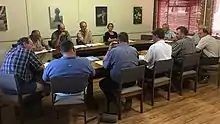
Although Orania lies within the borders of the Thembelihle municipal area, it is not an administrative part of the Thembelihle Local Municipality. Orania maintains its own municipal administration, while Thembelihle provides no services (such as sewerage, roads, rubbish collection) to Orania,[138] and collects no rates from the town (other taxes are paid normally).[178][179] In 2011, town rates for residents were between R1,500 and 2,000 per month.[180]
The town's existence is permitted by the Constitution of South Africa under Section 18, which guarantees the right to freedom of association, Section 30, which guarantees language and cultural expression and Section 31, which provides for the right to form cultural, religious or linguistic communities. Orania has a non-confrontational attitude towards South African authorities, which have likewise adopted a non-interference policy towards Orania.[181] The ANC government mostly avoids the issue of Orania and its status, as it is seen as less important than many other political issues the party faces.[182]
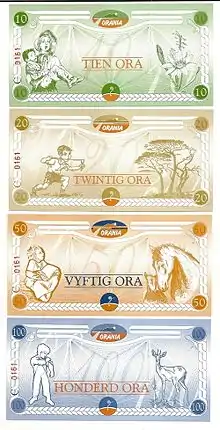
Private company
The town is privately owned by the Vluytjeskraal Aandeleblok company (VAB, Vluytjiekraal Share Block). Ownership of plots and houses is in the form of shares in the company,[106] according to a framework known as 'share block' under South African law, similar to the strata title or condominium in other countries.[183][105] No title deeds are provided, except for agricultural land.[184] Share blocks are linked to portions of the company's real estate property, and the shareholder acquires the right to use property linked to their share block.[185]
A general meeting of shareholders is held every year.[185] The shareholders, numbering about 400 as of 2017, vote for the company's board of directors.[186] The eight people on the board of directors form the village council (Dorpsraad).[187] The board of directors elects a chairperson, who serves as the town's mayor, and an executive officer who is responsible for the daily administration of the town.[187] Other members of the board are given responsibility for community matters such as safety, planning and community services.[187]
Parts of the community are critical of the share block arrangement, as it offers no effective representation to people who rent their house, and thus are not shareholders in the company.[188] Even shareholding residents feel they have only a limited say in the management of Orania.[189]
Vluytjeskraal functions like a municipal administration, being funded by rates and delivering services like water, electricity and waste management.[187][106] Utility companies like Eskom and Telkom provide services to this private entity, which then splits the costs and charges the end users.[138] The budget for the fiscal year 2006/2007 was R2.45 million.[190] Harry Theron is the company chairman as of 2018; Frans de Klerk is the chief executive officer.[191]
Kambrolandskap Koöperatief is a separate legal entity acquiring land on Orania's behalf.[192] It owns land plots in share blocks, just like Vluytjeskraal Aandeleblok.[192]
Democratic institutions
The Orania Verteenwoordige Raad (OVR, Orania Representative Council) is an elected institution, tasked with handling Orania's political interests in negotiations on the provincial and national levels.[193] It is the last transitional representative council extant in South Africa. The Representative Council is elected by all residents, including those who own no shares in the company.[186]
Orania has its own municipal structure in the form of the Orania Representative Council based on the Local Government Transition Act of 1993, where other municipalities are based on the Municipal Structures Act of 1998. This legal framework was laid down in 2000 when an agreement between the Cabinet of South Africa, the Northern Cape government and the Orania Representative Council was reached about a provisional status for Orania. This agreement was confirmed by a ruling of the Northern Cape High Court.[194]
Orania residents are eligible to vote in the Thembelihle municipal elections, but few choose to do so.[195]
Administration & Welfare

Orania receives no fiscal contributions from either state or provincial government, and must generate all funds itself.[196]
Orania has a 3 step program of dealing with destitute Afrikaner arrivals: stabilisation, rehabilitation and integration. First they are supplied with housing, next work, and then land at 10% of market value + interest-free loans from the local co-operative bank for the construction of a house.[66] The Helpsaam Fund, a non-profit institution, raises money for projects like subsidised housing for newcomers in need.[197][106] The Elim Centre accommodates unemployed young men who come to Orania seeking employment.[198] Most are destitute when they arrive.[199] They are usually given work with the municipality or local farms, and provided with training.[178] Nerina, the equivalent residential complex for women, was completed in July 2012.[200]
The Orania Beweging (Orania Movement) is a local political and cultural organisation that promotes Afrikaner history and culture.[201] The Orania Movement has around 3,800 registered supporters from outside town.[202]
In 2013, Orania had a small clinic, and a government-funded nurse visited twice a month.[196] By 2020, the town had a doctor, a fisiotherapist, a radiographer and a pharmacist according to Frans De Klerk (head of the Orania Development Company.[203][204] The town has two airstrips, one 1,300 metres (4,300 ft) and the other 1,000 metres (3,300 ft).[205]
Since 1994, citizens of Orania have voted in the six national elections. Over the last three elections, Orania had an average vote turnout of 65%, based on registered voters. In the South African general elections in 2004,[206] 2009,[207] and 2014,[208] the community voted decisively for the Freedom Front Plus party. The four votes recorded for the Economic Freedom Fighters party in the 2014 election elicited a number of comments from South African media.[209]
Town authorities have a strong focus on green practices, including recycling and conservation.[210][10] Solar geysers are a requirement for all new houses built in Orania.[211] In 2014 Orania opened its bicycle sharing system, called the Orania Openbare Fietsprojek (Orania Public Bicycle Project).[76]
The Boshoff family are regarded as the 'political elite' of Orania.[212] They are generally seen as being relatively more liberal than most of the town's other residents.[212]
Law enforcement
.jpg.webp)
The town has neither a police force nor a prison.[113] Traffic monitoring and minor crimes such as petty theft are handled internally.[183][213] Volunteers carry out neighbourhood watch patrols.[213] In October 2014 Orania Veiligheid (Orania Security) was established, to handle reports of illegal activities such as drug dealing or car theft, but also more trivial matters such as littering and noise complaints.[214] Apprehended suspects are taken to the police station in neighbouring Hopetown.[215] Police are only called in as a last resort.[216] Residents are exhorted to use mediation and arbitration procedures made available by the town council, rather than resorting to South African courts.[106]
South Africa has a high crime rate with: 58 murders, 113 rapes, 587 robberies and 605 house burglaries per day.[217] Between 1994 and 2018 more than 500,000 people were murdered in South Africa.[218] "Crime" is given as the main reason by emigrating South Africans, who are leaving at a pace consistent with the advent of "widespread disease, mass natural disasters or large-scale civil conflict".[219][220] In contrast, Orania's residents perceive it as being crime free, where their children can grow up safe.[4]
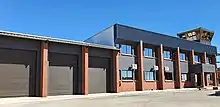
In 2017 local media reported on child abuse committed by an elderly Orania resident which went undetected for years.[221]
In 2019 the SAPS's Child Protection Unit visited the Volkskool Orania school to investigate a case of statutory rape against a student teacher. The student teacher was charged before the Hopetown Magistrate's Court.[222][223]
Application process
Prospective residents are required to go through an interview process with a committee, which may deny access to people based on criteria such as criminal records.[224][113] Once permission is granted, the new residents become members of the community, either as shareholders if they buy property, or as tenants.[113]
Being an Afrikaner is the most important criterion for admission.[4] Although there are news sources that claim that black or coloured people are not allowed to live in Orania,[21] the town's spokesman insists that there are no rules against admitting them as residents.[202] Though the community is not supportive of same-sex relationships, some gay people do live in Orania.[225] Unmarried couples living together are also frowned upon.[226]
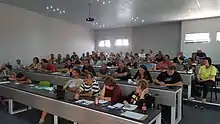
Some people who try to live in Orania leave due to the limited choice of available jobs or the requirement to conform to local social norms.[227][104] According to a 2004 study, 250 people had left Orania since its establishment in 1991, most of them due to "physical and social pressure".[228] The difference in lifestyle compared to an urban environment is another factor that negatively impacts newcomers.[229]
External relations

Over the years, Orania has been visited by many public figures, including Northern Cape Premier Dipuo Peters (in 2004),[230] Julius Malema (in 2009),[231] Desmond Tutu (in 2010),[232] and former President Jacob Zuma (in 2010).[233]
In June 2007, the Cape Coloured community of Eersterust, outside Pretoria visited the Afrikaner enclave.[234] The groups met to discuss community development and discussed methods of self-governance.[234] On 4 July 2007 the town of Orania and the Northern Cape government agreed that all government levels should discuss the question of Orania's self-government.[235]
Orania and the Xhosa community of Mnyameni signed a cooperation agreement in December 2012,[236] to assist in the development of own institutions and the transfer of knowledge between the communities.[237][238]
Members of the Orania Beweging, including its president Carel Boshoff, went on a European tour in 2013, meeting with MPs from the Partij voor de Vrijheid of the Netherlands, the Vlaams Belang party in Belgium and Südtiroler Volkspartei in Italy's South Tyrol province.[239][240][241]
Boshoff rejected an invitation to the funeral of Afrikaner Weerstandsbeweging (AWB) leader Eugene Terre'Blanche in April 2010, as he saw him as having chosen a path of confrontation and conflict.[242] Boshoff IV also noted that the Orania concept was at odds with the baasskap system of the apartheid period.[32]
Elections
Since 1994, citizens of Orania have voted in the five national elections. Over the last three elections, Orania had an average vote turnout of 65%, based on registered voters. In the South African general elections in 2004,[243] 2009,[207] and 2014,[244] the community voted decisively for the Freedom Front Plus party. The four votes recorded for the Economic Freedom Fighters party in the 2014 election elicited a number of comments from South African media.[209] In the 2019 general elections the EFF took its members from surrounding areas to the voting station in Orania.[245]
| Party | Votes | % | +/− | ||||||
|---|---|---|---|---|---|---|---|---|---|
| Freedom Front Plus | 447 | 79.40 | |||||||
| Democratic Alliance | 62 | 11.01 | |||||||
| Economic Freedom Fighters | 21[lower-alpha 2] | 3.73 | |||||||
| Front National | 12 | 2.13 | |||||||
| Congress of the People | 8 | 1.41 | |||||||
| Total | 550 | ||||||||
| Source: IEC | |||||||||
| Party | Votes (2004[247]) | % (2004) | Votes (2009[207]) | % (2009) | Votes (2014[248]) | % (2014) |
|---|---|---|---|---|---|---|
| Freedom Front Plus | 158 | 84.95% | 242 | 86.73% | 224 | 76.89% |
| Democratic Alliance | 16 | 8.60% | 26 | 9.31% | 44 | 15.12% |
| African Christian Democratic Party | 3 | 1.61% | 3 | 1.07% | 7 | 2.41% |
| African National Congress | 3 | 1.61% | 3 | 1.07% | 5 | 1.72% |
| Congress of the People[lower-alpha 3] | - | - | 3 | 1.07% | 1 | 0.34% |
| National Action[lower-alpha 4] | 3 | 1.61% | - | - | - | - |
| Independent Democrats[lower-alpha 5] | 2 | 1.08% | 0 | 0% | - | - |
| New National Party [lower-alpha 6] | 1 | 0.54% | - | - | - | - |
| Economic Freedom Fighters [lower-alpha 7] | - | - | - | - | 4 | 1.37% |
| Front National[lower-alpha 7] | - | - | - | - | 4 | 1.37% |
| Ubuntu Party[lower-alpha 7] | - | - | - | - | 2 | 0.69% |
| Spoilt votes | 2 | 1.08% | 2 | 0.71% | 0 | 0.00% |
| Total | 188 | 100.00% | 279 | 100.00% | 291 | 100% |
- Notes
- USD conversion using the end-of-year rate from the South African Reserve Bank
- On the election day, a group of non-resident EFF party members from Hopewell, Northern Cape cast their ballots in Orania as a political act.[246]
- Party did not contest in elections before 2009.
- Party only contest in the 2004 elections and then submerged into the Freedom Front, making it the Freedom Front Plus
- Merged into the Democratic Alliance in 2012.
- Merged into the African National Congress in 2005.
- Party did not contest in elections before 2014.
Economy

More than 244 businesses are registered in Orania as of 2019, and town leaders reported economic growth in excess of 11%.[2] [249] In contrast South Africa's growth rate for 2019 was 0,2%.[250] In the same year, the Guardian newspaper reported that "Orania is Booming".[226] In 2020, Dirk Herman, the leader of the Solidarity Trade Union reported after a visit, "that Orania was growing so rapidly, that he could hear it grow".[251]
In 2019 Orania's workforce was employed as follows: 269 Service providers, 140 traders, 76 construction workers, 19 hospitality providers, 12 manufacturers, 66 in education, 27 agricultural service providers. The town hosts diverse industries, from macadamia farming, a toffee factory, a brewery, a call centre, stockbroking services, architecture, construction etc.[113]
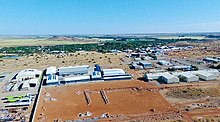
The average wage in Orania was estimated at approximately R94,036[2] per annum in 2019, low by white South African standards.[252] The lack of cheap black labour means that living expenses in Orania is more expensive than the rest of South Africa;[202] at the same time, unskilled workers are scarce.[199] In 2015, a visiting journalist estimated the poverty rate at 70–80%.[253]
In Orania people from all levels of society perform their own manual labour.[21] Local Afrikaners also work in unskilled positions such as gardening and waste collection.[254] In 2009, 14% of the population was self-employed.[255] Rapid growth over the four years to 2014 led to the construction of new commercial developments and a rising number of young adult immigrants, but also caused an increase in class differences between residents.[256]
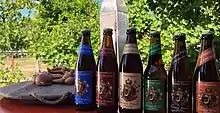
Orania's tourism industry is showing rapid development with the completion of a luxury river spa and boutique hotel complex in 2009.[257] Orania Toere (Orania Tours), Orania's first registered tour operator, was also launched in 2009. In 2010 thirteen independent hospitality businesses operated in Orania,[258] including a caravan park, self-catering flats, rooms, hotel and guest-houses.[10] From October 2012 to February 2013, about 2,000 holidaymakers visited the town.[259]
The Orania Chamber of Commerce was established in 2001.[27] The Orania Spaar- en Kredietkoöperatief (Orania Savings and Credit Co-operative) is a local cooperative bank. It registered with the South African Reserve Bank in 2011, and in 2013 it had R45 million in savings deposits.[260]
During April 2004, Orania launched its own monetary system, called the Ora, based on the idea of discount shopping vouchers.[261][18] Orania launched its own chequebook in 2007.[262] The enclave is currently working to introduce the e-Ora, a digital version of the currency that is currently in circulation.[263]
Previously, a permit was required to start new businesses in town, which was only granted if the new business did not compete with existing ones.[116] The permit system proved unworkable, causing dissatisfaction among the residents, and was abolished.[264]
Agriculture
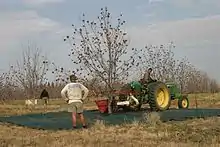
Farming is an important part of Orania's economy, the most prominent project being a massive pecan nut plantation,[265][266] one of the largest in South Africa.[152] The plantation is said to have given Orania a substantial economic boost.[159] Most of the agricultural production is exported to China.[249] Since purchasing the 430-hectare (1,100-acre) town, the community has added 7,000 hectares (17,000 acres) of agricultural land to it.[267] A pumping station on the Orange River, financed and built by the town's residents, provides water for agricultural use.[230] The station is connected to a 9-kilometre (5.6 mi) pipeline.[97]

A R9 million dairy farm, the Bo-Karoo Suiwel, operated in Orania from 1998 to 2002. Though deemed one of the most modern dairies in South Africa at the time,[104] the increased cost of imported machinery caused by a decline in value of the rand combined with a rise in the price of corn used to feed cattle led to its liquidation.[268][269] Another ambitious project, a mill processing a range of corn products, was completed in 2005,[270] but also proved unsuccessful and was closed down.[271] The Orania management has since mostly eschewed large-scale projects, rather focussing on small- and micro-enterprises to develop the local economy.[271]
Construction

The construction industry is an important element of the local economy. Orania counts 8 construction companies as of 2017.[272] During 2020 the town set out and serviced 100 new stands, and has enough land available for a further 4200 erven, according to Frans De Klerk (head of the Orania Development Company.[273]
In 2010 property prices ranged from R250,000 at the low-end, up to R900,000 for new riverfront property. By 2020, property prices ranged from R420,000 at the low-end, up to R2,900,000 for a detached house.[274][275] Average house prices in Orania have grown by 13.9% a year from 1992 to 2006.[276]

The shortage of affordable housing is a significant problem in Orania.[277] Given the relatively low local wages, even two mid-range salaries might not be enough to buy a house.[277] Outside investors, who can afford to pay more using savings from previous employment outside Orania, inflate housing prices.[277] While buildings from the Water Works era can rely on pre-existing utility connections, new builds face the additional cost of installing infrastructure, raising prices further.[277]
In 2013, the Sonskip / Aardskip earthship living museum construction started in Orania,[278] designed by Christiaan van Zyl, one of South Africa's foremost experts on sustainable architecture.[279] The building is open to the public as a living museum; it is the largest earthbag earthship in the world.[279]
Culture

Cultural institutions include the Orania Kunsteraad met orkes en koor (arts council with orchestra and choir) and the Orania Kultuurhistoriese museum (cultural history museum).[190] Exhibits housed in the museum include the Felix Lategan gun collection and a Vierkleur flag carried by Jopie Fourie.[280] A collection of busts of Afrikaner leaders, sourced from institutions that no longer wanted them after the end of apartheid, sits on a 'monument hill' outside town.[152] There is also a Verwoerd museum, where items and photos of Hendrik Verwoerd are on display. It was the house where his widow lived from 1992 until her death at the age of 98 years in 2000.[281][152]
The Koeksistermonument, erected in 2003, celebrates the women who baked and sold koeksisters to collect money for charity and is one of the town's tourist attractions.[282] The town also houses the Irish Volunteer Monument, dedicated to the Irish soldiers who fought on the Boer side during the Boer War (see Boer foreign volunteers).[152] Jan van Wijk, who also created the Afrikaans Language Monument in Paarl, designed the monument. It was moved from Brixton, Gauteng in 2002 by a group of Afrikaners concerned by its imminent demolition.[152]

Orania has a mascot named Klein Reus (small giant), a small boy shown rolling up his sleeves.[283][152] The symbol is used for the town's flag, its currency and merchandise.[200] Traditional Afrikaner cultural activities such as volkspele dances and games of jukskei are promoted within the community.[284] Karoo-style food such as skaapkop (sheep's head) is part of the local culinary heritage.[284]
Like most South Africans, Orania residents are rugby fans.[285] The town has a rugby team, the Orania Rebelle, playing in the Griqualand West Rugby Union.[286]
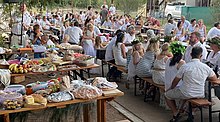
The Orania Karnaval (formerly Volkstaatskou) is the main cultural event in town. Held annually since April 2000,[287] it features exhibitions, competitions and concerts from local and national Afrikaner artists,[288] with food stalls offering traditional Afrikaner treats. The Ora currency and the Kleinreus flag were both introduced during the celebrations.[290][291]
Younger residents occasionally complain of a lack of recreational activities, a concern common to many small communities.[292] Orania, a farming town, offers few amusements to teenagers and young adults, who miss the entertainment offered by city life.[293] Things improved considerably with the opening in 2014 of the Ou Karooplaas shopping centre, which also houses a cinema, pizza parlor and DVD shop; and the Stokkiesdraai Adventure Park, which also has a pub and coffee shop.[253]
Education

The Orania Koördinerende Onderwysraad supervises all educational activities in Orania.[294] Orania's schools have consistently achieved a 100% matric pass rate since 1991.[295] With the rest of South African students averaging between 60% and 82% matric pass rates between 2008 - 2019.[296]
There are two schools, the CVO Skool Orania (Christelike Volks-Onderwys or Christian People's Education) and Volkskool Orania (Orania People's School).[297] Afrikaans is the language of instruction, while English is taught as a second language.[60] Both schools follow the IEB curriculum;[298] the CVO school offers a more conservative education, while the Volkskool is relatively more progressive.[299]

The CVO-school, established in January 1993,[118] is run along conventional lines; enrolment in 2014 was 225 students, with some coming from neighbouring towns.[300] The school is growing with a record amount of 400 students enrolled in January 2021. The CVO School includes Christian tenets as a vital part of the education, and is part of the Beweging vir Christelik Volkseie Onderwys, a network of similarly minded schools across the country.[301] As a Reformed Christian school, its teachings are in accordance with the Canons of Dort.[302] In November 2020, the construction of 12 new classrooms started.
The Volkskool, established in June 1991 with Julian Visser as its first principal,[118] uses a self-driven teaching (selfgedrewe) system which is unorthodox by South African standards.[303] Because the town had few school-aged children when it was established, the school adopted a computer-based learning system that allowed students of different levels to be taught by a single teacher.[304] The Volkskool's e-learning system was seen as innovative and received attention from South African media in the early 2000s.[305][306]
There is a rivalry between the schools, which is generally friendly but can occasionally become quite fierce.[307] Not all local children attend them, as some parents choose homeschooling or boarding schools in cities such as Bloemfontein.[167]
Bo-Karoo Opleiding, a vocational training college, offering courses in technical subjects such as welding, metalworking and engineering, was opened in 2017.[308][309]
Media
The Independent Communications Authority of South Africa (ICASA) shut down the first local community radio, Radio Club 100, in November 2005 for broadcasting without a licence and being a "racist-based station".[310] The station's management contended they had repeatedly applied for a licence and were merely carrying out tests, and that they broadcast harmless news about birthdays and social events.[310] ICASA granted a licence to the new Radio Orania in December 2007,[311] and the station began broadcasting on 13 April 2008 on 95.5 MHz.[312] The community station is run by volunteers and counts over 50 contributors.[313] Programmes include readings of Afrikaans literature such as Mikro's Die ruiter in die nag.[314]
Dorpnuus, the town hall's newsletter, was launched in November 2005 and reports on local events and meetings of the town council.[315] Volkstater is an independent local publication that is sent to supporters of the volkstaat idea, mostly non-residents of Orania. and deals with local events and Afrikaner history.[316] Voorgrond, a publication of the Orania Beweging, is aimed primarily at non-residents who support the movement.[317]
Cultural holidays
_(2).jpg.webp)
Geloftedag on 16 December is one of the most important holidays for the community. Locals wear traditional clothing and commemorate the victory in 1838 of 470 Afrikaners over an army of 15,000 Zulu warriors.[318]
A list of cultural holidays in Orania:[319]
| Date | Afrikaans Name | English Translation | Significance |
|---|---|---|---|
| 27 February | Majubadag | Majuba Day | Date of the Battle of Majuba Hill ending the First Boer War |
| 6 April | Stigtingsdag | Founder's Day | The Dutch explorer Jan van Riebeeck arrives in Cape Town, 1652. Also celebrated for the founding of Orania in 1991. |
| 31 May | Bittereinderdag | Bitter Enders' Day | Date of the Treaty of Vereeniging ending the Second Boer War. Also the founding date of the Republic of South Africa in 1961 and previously celebrated as Republiekdag. |
| 14 August | Taaldag | Linguistics Day | Celebrates the Afrikaans Language and Literature |
| 10 October | Heldedag | Heroes' Day | Birthday of Paul Kruger, 3rd President of the South African Republic |
| 16 December | Geloftedag | Day of the Vow | Date of the Battle of Blood River, defining battle of the Great Trek |
Works about Orania
The unusual and controversial nature of Orania has drawn the interest of researchers,[320] especially in the field of anthropology. Kotze (2003) examines Orania as a case of a non-declining small town in South Africa.[321] Steyn (2004) elaborates on the town's bottom-up approach to development.[321] De Beer (2006) considers the achievements of Orania, deeming it unlikely that it will ever succeed in bringing about self-determination.[321] Terisa Pienaar analyzed the volkstaat concept, and the suitability of Orania as a growth point for a volkstaat.[322] Lindi Todd included Orania in a study on how the Afrikaner identity developed after the end of apartheid.[322] Liesel Blomerus focused on the identity of Afrikaner women in the town. Lise Hagen addressed the concepts of space and place in Orania.[322] South African economist Dawie Roodt described the town as being "like a Petri dish" for economic research.[323]
In September 2012, a German documentary film titled Orania premiered at London's Raindance Film Festival. The film is a sociological study of the town.[324] The town was also featured in a 2009 documentary produced by France Ô, Orania, citadelle blanche en Afrique[325][326] and in a 2018 documentary produced by Lauren Southern, Farmlands.[327][328]
See also
Notes
- "Main Place "Orania"". Census 2011. Archived from the original on 9 November 2013. Retrieved 10 January 2014.
- "Orania Sensus 2019" (PDF). Orania Sakekamer. Retrieved 17 December 2020.
- https://web.archive.org/web/20160811232104/http://mg.co.za/article/2016-08-05-00-it-may-only-have-1-000-residents-but-orania-wants-to-move-from-dorp-to-city
- Fihlani, Pumza (6 October 2014). "Inside South Africa's whites-only town of Orania". BBC News. Archived from the original on 6 October 2014. Retrieved 6 October 2014.
- Burgt 2016, p. 15.
- Haleniuk 2013, p. 4.
- Burgt 2016, p. 88: "More than once inhabitants clarified to me that anyone can come live in Orania, as long as they identify with the Afrikaner cause."
- Standley, Jane (16 December 2000). "Rainbow nation at risk?". BBC News. Archived from the original on 12 April 2015. Retrieved 12 April 2015.
- Daley, Suzanne (4 May 1999). "Orania Journal; Afrikaners Have a Dream, Very Like the Old One". NYTimes.com. Archived from the original on 27 May 2015. Retrieved 12 April 2015.
- Louw, Poppy (29 April 2014). "20 years of democracy in Orania: The past might have a future". Times LIVE. Archived from the original on 30 March 2015. Retrieved 31 March 2015.
- Leboucher, Quentin (8 May 2013). "We're not racists, say Orania residents". IOL News. Archived from the original on 12 April 2015. Retrieved 12 April 2015.
- https://www.youtube.com/watch?v=EG2OPwYFQ20
- Gannon,LiveScience, Megan. "Race Is a Social Construct, Scientists Argue". Scientific American. Retrieved 31 January 2021.
- "Race and Racial Identity Are Social Constructs". www.nytimes.com. Retrieved 31 January 2021.
- "Orania and the third reinvention of the Afrikaner - Carel Boshoff - DOCUMENTS | Politicsweb". www.politicsweb.co.za. Retrieved 31 January 2021.
- https://www.youtube.com/watch?v=mSfhafvTP6w
- https://www.justice.gov.za/legislation/constitution/history/INTERIM/TCR/ACCORD.PDF
- "'Whites-only' money for SA town". BBC News. 29 April 2004. Archived from the original on 8 January 2015. Retrieved 12 April 2015.
- Bezuidenhout, Nick (5 June 1998). "VF se strewe legitiem, sê Moosa" [Freedom Front endeavour legitimate, says Moosa] (in Afrikaans). Beeld. Archived from the original on 3 July 2011.
- Burgt 2016, p. 58-62.
- "10 years on, Orania fades away". News24.com. 22 April 2004. Archived from the original on 17 December 2014. Retrieved 10 April 2015.
- Mwakikagile, Godfrey (2008). South Africa in Contemporary Times. Intercontinental Books. p. 110. ISBN 978-0-9802587-3-8. Archived from the original on 4 February 2017.
- Buncombe, Andrew (13 December 2013). "We shed no tears for Nelson Mandela. He is a fallen opponent, say residents of white enclave Orania". The Independent. Archived from the original on 25 September 2015. Retrieved 1 April 2015.
- https://www.youtube.com/watch?v=EG2OPwYFQ20
- admin. "Barefoot woman (Kaalvoet vrou)". Retrieved 31 January 2021.
- Burgt 2016, p. 34.
- "Die Orania Tydlyn". Voorgrond (in Afrikaans). Orania Beweging. July 2011. pp. 5–11. Archived from the original on 10 April 2015. Retrieved 4 April 2015.
- https://www.nda.agric.za/docs/abstract04/Population.pdf
- Schonteich & Boshoff 2003, p. 39.
- Parks, Michael (11 October 1986). "Form Afrikaner Nation, Rightist Urges". Los Angeles Times. Archived from the original on 16 April 2015. Retrieved 4 April 2015.
- Schonteich & Boshoff 2003, p. 44.
- Donaldson, Andrew (25 April 2010). "All white, and a bit green, in the far country". Times LIVE. Archived from the original on 28 April 2010. Retrieved 14 April 2015.
- Schonteich & Boshoff 2003, p. 42.
- Burgt 2016, p. 43-44.
- Christopher 2002, p. 101.
- Schonteich & Boshoff 2003, p. 45.
- Groenewald, Yolandi (1 November 2005). "Orania, white and blue". Mail & Guardian. Archived from the original on 6 January 2014. Retrieved 6 January 2014.
- Biehl, Sebastiaan (23 May 2014). "Orania van dorp tot stad – 'n nuwe strategie. Boek bied belangrike nuwe strategie". Orania Blog. Archived from the original on 7 February 2018. Retrieved 5 February 2018.
- Boshoff, Carel (1 July 2016). "Brexit, "die Volkstaat" en dié se vreeslike bagasie". Orania Blog. Archived from the original on 7 February 2018. Retrieved 6 February 2018.
- de Klerk, Frans (10 September 2015). "Van dorp tot Afrikanerstad". Netwerk24 (in Afrikaans). Archived from the original on 6 February 2018. Retrieved 6 February 2018.
- Burgt 2016, pp. 46; 139.
- "Strategie". Orania Beweging (in Afrikaans). Retrieved 31 January 2021.
- Hagen 2013, p. 128.
- Hagen 2013, p. 211.
- https://www.mrc.org/special-reports/liberal-mediaevery-poll-shows-journalists-are-more-liberal-american-public-%E2%80%94-and
- Balan, Matthew (19 October 2009). "Journalists Admitting Liberal Bias, Part One". Media Research Center. Retrieved 31 January 2021.
- Concha, Joe (7 May 2014). "Liberal Media? 7% of Journalists Say They're Republicans". The Daily Beast. Retrieved 31 January 2021.
- Delvecki & Greiner 2014, pp. 164–173.
- Musekwa, Rudzani Floyd (20 May 2014). "Is Orania a racist enclave, or a misunderstood cultural concept?". The New Age Online. Archived from the original on 4 April 2015. Retrieved 4 April 2015.
- Keller, Bill (26 February 1994). "Orania Journal; In a 'Whites Only' Utopia, No Escaping Discord (Published 1994)". The New York Times. ISSN 0362-4331. Retrieved 3 February 2021.
- Drogin, Bob (28 February 1994). "Zealots' Dream Falters in Whites-Only S. Africa Town : Racism: Bastion of intolerance sees itself as model. But glimpse of future disappoints some separatists". Los Angeles Times. Archived from the original on 16 April 2015. Retrieved 4 April 2015.
- Szechenyi, Christopher A. (30 March 1995). "A Segregated Town Survives In South Africa". Chicago Tribune. Archived from the original on 10 April 2015. Retrieved 4 April 2015.
- Keller, Bill (16 August 1992). "Party's Split Casts Shadow On a Dream". The New York Times. Archived from the original on 3 February 2018. Retrieved 3 February 2018.
- Nikitin, Vadim (16 September 2011). "Bigotry without racism? -- Lessons from Orania". Mail & Guardian. Archived from the original on 1 June 2015. Retrieved 4 April 2015.
- Schadomsky, Ludger; Collins, Charlotte (10 December 2003). "Apartheid's last stand". The Independent. Archived from the original on 11 April 2015. Retrieved 4 April 2015.
- Pogrund 2014, p. 131.
- Nikitin, Vadim (15 April 2011). "Inside South Africa's last bastion of apartheid". The National. Archived from the original on 24 October 2015. Retrieved 4 April 2015.
- "Orania - endast för vita" (in Swedish). Sveriges Radio. 31 March 2015. Archived from the original on 4 March 2016. Retrieved 7 April 2015.
- Fairbanks, Eve (Spring 2013). "Pardon'd". Witness. 26 (1). Archived from the original on 3 February 2018. Retrieved 2 February 2018.
- Kirchick, James; Rich, Sebastian (1 July 2008). "In Whitest Africa". VQR Online. Archived from the original on 11 April 2015. Retrieved 4 April 2015.
- Fairbanks, Eve (23 March 2011). "Death of a True Afrikaner Believer". Foreign Policy. Archived from the original on 14 April 2015. Retrieved 7 April 2015.
- Louw, Leon. "Orania is not a home for racial bigots". Acts Online News. Archived from the original on 31 July 2017. Retrieved 31 July 2017.
- Embassy Pretoria (21 December 2004). "Cable 04PRETORIA5466, Cloud Cuckoo-land's Last Redoubt: A Visit To Orania". Wikileaks. Retrieved 7 April 2015.
- "Orania: The Little Town that Racism Built". www.vice.com (in Swedish). Retrieved 31 January 2021.
- Africa, Forbes Woman (1 February 2017). "The Rainbow Nation's Whites-Only Town". Forbes Africa. Retrieved 31 January 2021.
- Davis, Rebecca (21 January 2020). "From the Vault: 'Everyone in Orania is woke': A journey to SA's most notorious town". Daily Maverick. Retrieved 31 January 2021.
- "Andrew Kenny's "Orania" column they don't want you to read". BizNews.com. 30 October 2015. Retrieved 31 January 2021.
- de Beer 2007, pp. 45-58.
- Wren, Christopher S. (8 May 1991). "A Homeland? White Volk Fence Themselves In". NYTimes.com. Archived from the original on 19 April 2015. Retrieved 4 April 2015.
- Sly, Liz (16 March 1992). "'All-White' Town Finds It Can't Live Without Blacks". Seattle Times. Archived from the original on 10 April 2015. Retrieved 4 April 2015.
- du Toit, Pieter (13 January 2010). "Volkstaat hou g'n heil in" (in Afrikaans). Beeld. Archived from the original on 9 May 2016. Retrieved 14 April 2015.
- Pienaar 2007, p. 45.
- Pienaar 2007, p. 46.
- Masilela, Johnny (27 September 2015). "Orania leader true racists love to hate". Sunday independent. Archived from the original on 6 March 2016. Retrieved 11 October 2015.
- Fitzpatrick, Marida (30 January 2010). "Ook net mens". Die Burger (in Afrikaans). Archived from the original on 30 September 2011. Retrieved 5 January 2014.
- van den Heever, Juran (23 February 2015). "Orania – Nie so 'n vergesogte droom nie" (in Afrikaans). AfriForum. Archived from the original on 10 April 2015. Retrieved 5 April 2015.
- "Helpsaamfondsdinee saam met Steyn Fourie ten bate van die Elim steen vir steen Projek" (PDF) (in Afrikaans). Orania Beweging. May 2009. Archived (PDF) from the original on 5 March 2016. Retrieved 15 April 2015.
- Tobias Lindner. Orania (audio commentary) (in German and English). VHX. Event occurs at 53:35.
- "Orania: These building projects show how "whites-only" town is growing". The South African. 25 October 2019. Retrieved 31 January 2021.
- https://twitter.com/OraniaHomeland/status/1050080302364848133
- Beirne, Aodhan (22 December 2018). "Corruption in South Africa: A Guide to Our Recent Reporting (Published 2018)". The New York Times. ISSN 0362-4331. Retrieved 31 January 2021.
- Favour, Adeaga (1 June 2020). "Here is all you should know about corruption in South Africa". Briefly. Retrieved 31 January 2021.
- "Top 10 Corruption Scandals that Rocked South Africa as a Nation". BuzzSouthAfrica. 25 September 2015. Retrieved 31 January 2021.
- Bloomberg. "South Africa's economy is in its longest downward cycle in 75 years – and new restrictions will likely extend it". Retrieved 31 January 2021.
- "The many, many race laws of the ANC - NEWS & ANALYSIS | Politicsweb". www.politicsweb.co.za. Retrieved 31 January 2021.
- https://solidariteit.co.za/wp-content/uploads/2017/10/Racism-hate-speech-and-double-standards-by-no-means-a-mere-matter-of-bla....pdf
- Nuus, Forum (8 October 2020). "Solidariteit stel grootste opstaanprojek in 118 jaar bekend". AfriForum (in Afrikaans). Retrieved 31 January 2021.
- "Solidariteit stel Werkherstelprogram van R4,7 miljard bekend". Wêreldwyd (in Afrikaans). 8 October 2020. Retrieved 31 January 2021.
- "HuffPost is now a part of Verizon Media". consent.yahoo.com. Retrieved 3 February 2021.
- "SA will become failed state if decline isn't arrested immediately". www.iol.co.za. Retrieved 31 January 2021.
- "South Africa's Decline Is Worst Among Nations Not at War, Model Shows". Bloomberg.com. 17 April 2019. Retrieved 31 January 2021.
- "How world sees SA: EWC will push it to 'failed state' status, warns Trump right-hand man". BizNews.com. 19 February 2020. Retrieved 31 January 2021.
- https://www.sowetanlive.co.za/authors/prince-mashele. "Without private sector SA will be a failed state, thanks to ANC". SowetanLIVE. Retrieved 31 January 2021.
- https://www.linkedin.com/pulse/state-south-africa-2020-johan-marais
- "VF Plus bied konferensie oor selfbeskikking aan". Maroela Media. 14 October 2020. Retrieved 31 January 2021.
- https://www.youtube.com/watch?v=d8ycILnD31Y
- Opperman, M. "The Residential Development on the Farm Vluytjes Kraal Noord, Orania" (PDF). South African Heritage Resources Agency. Alt URL
- Burgt 2016, p. 78.
- Opperman, Manie (August 2011). "The Vermeulen Engravings: Binding Six Afrikaner Generation". EBSCO Online Library. Archived from the original on 11 April 2015. Retrieved 5 April 2015.
- Burgt 2016, p. 46.
- Haleniuk 2013, p. 3.
- Pienaar 2007, p. 57-58.
- Pienaar 2007, p. 58.
- McGreal, Chris (29 January 2000). "A people clutching at straws". The Guardian. Archived from the original on 2 April 2015. Retrieved 1 April 2015.
- Cavanagh 2013, pp. 69–75.
- Boshoff, Carel (7 October 2014). "Orania and the third reinvention of the Afrikaner". Politicsweb. Archived from the original on 2 April 2015. Retrieved 31 March 2015.
- Cavanagh 2013b, p. 404.
- "Making way for Orania's Boere" (PDF). South African Press Association. 8 April 1991. Archived (PDF) from the original on 12 February 2016. Retrieved 4 February 2018.
- Pienaar 2007, p. 59.
- Moutout, Corinne (18 March 1991). "Les Afrikaners "pure souche" rêvent d'une patrie indépendante et ont déjà créé "Orania"" (in French). Le Soir. Archived from the original on 18 April 2015. Retrieved 18 April 2015.
- Burgt 2016, p. 47.
- Hagen 2013, p. 47.
- Craw, Victoria (1 November 2014). "Orania: South Africa's last apartheid town". News.com.au. Archived from the original on 31 March 2015. Retrieved 31 March 2015.
- van Nuijsenburg, Peter (14 August 1993). "Boeren eisen een exclusief stukje Afrika". Provinciale Zeeuwse Courant (in Dutch). p. 25. Archived from the original on 7 February 2018. Retrieved 7 February 2018.
- Cuffaro, Maria. "Orania: The Israel of Africa?" (PDF). Work In Progress (July 1991). Archived (PDF) from the original on 4 February 2018. Retrieved 4 February 2018.
- Oosterbroek, Monica (31 July 1993). "Place to hide for the Volk" (PDF). Weekend Argus. Archived (PDF) from the original on 13 February 2016. Retrieved 4 February 2018.
- Cutting Edge. SABC Digital News. 21 January 2018. Event occurs at 20:00. Archived from the original on 6 April 2018. Retrieved 14 February 2018.
- Pienaar 2007, p. 60.
- Right-Wing Directory (PDF). Independent Board of Inquiry. March 1996. pp. 5–8. Archived (PDF) from the original on 14 August 2016. Retrieved 13 February 2018.
- "Orania lets election happen - but won't vote". IOL News. 1 December 2000. Archived from the original on 24 September 2015. Retrieved 7 April 2015.
- Pienaar 2007, p. 59-60.
- Daley, Suzanne (23 March 1999). "Beloved Country Repays Mandela in Kind". New York Times. Archived from the original on 20 November 2010. Retrieved 20 May 2010.
- "Millions of rands already invested in Orania". Orania.co.za. May 1998. Archived from the original on 20 April 1999. Retrieved 1 April 2015.
- Burgt 2016, p. 35-36.
- "Zuma's visit 'an outstanding day' for Orania". The Mail & Guardian. 14 September 2010. Retrieved 31 January 2021.
- https://www.youtube.com/watch?v=aJOXp29y0zI
- "Thabo Mbeki meets with the president of Orania". The South African. 9 August 2018. Retrieved 31 January 2021.
- https://www.youtube.com/watch?v=k6SdZJ-qtF8
- Burgt 2016, p. 49-50.
- Butcher, Tim (25 November 2000). "Black mayor to destroy dream of white homeland". Telegraph. Archived from the original on 12 April 2015. Retrieved 4 April 2015.
- "Mufamadi meets Orania representatives". News24. 12 March 2001. Archived from the original on 8 May 2016. Retrieved 10 April 2015.
- "Orania and N Cape govt to discuss future of enclave". Mail & Guardian. 4 July 2007. Archived from the original on 5 March 2016. Retrieved 6 April 2015.
- "Orania retains status quo". News24. 5 December 2000. Archived from the original on 10 September 2018. Retrieved 6 April 2015.
- Van Der Merwe, Hannatjie (9 May 2005). "'Mafia' regeer glo Orania" (in Afrikaans). Volksblad. Archived from the original on 10 April 2015. Retrieved 4 April 2015.
- Hagen 2013, p. 72.
- Groenewald, Yolandi (18 November 2005). "Coloureds Claim the Volkstaat". Mail & Guardian. Archived from the original on 10 November 2008. Retrieved 25 June 2006.
- "Orania Pleased at Land Claim". News24. 5 December 2006. Archived from the original on 17 February 2011. Retrieved 4 April 2010.
- de Wet, Phillip (5 August 2016). "Orania held its own election this week, buoyed by a vision of growth and prosperity". Mail & Guardian. Archived from the original on 11 August 2016. Retrieved 13 August 2016.
- Kemp, Charné (29 June 2016). "Orania ingesluit by EFF-kandidaat se groot planne". Netwerk24 (in Afrikaans). Retrieved 13 June 2017.
- "No 'shoot out' as Malema goes to Orania". www.iol.co.za. Retrieved 31 January 2021.
- Friedman, Daniel (29 April 2019). "We will 'relocate landless people' to 'whites-only places' like Orania – EFF". The Citizen. Retrieved 31 January 2021.
- "[LISTEN] Lesufi 'waging war on Afrikaans' - Afriforum". 702. Retrieved 31 January 2021.
- "Racist Lesufi once again disregards rights of Afrikaans-speaking communities in Combined School in Cullinan | SA-News.com". Retrieved 31 January 2021.
- https://www.youtube.com/watch?v=rCkfW1pfnjk
- "End of the Ora? Mounting calls for Orania to be shut down". SowetanLIVE. Retrieved 31 January 2021.
- Correspondent, Owen Slot, Chief Rugby. "South African minister: Why didn't our players take a knee?". ISSN 0140-0460. Retrieved 31 January 2021.
- "Black Lives Matter: Minister slammed for 'forcing athletes' to take a knee". The South African. 19 August 2020. Retrieved 31 January 2021.
- https://solidariteit.co.za/wp-content/uploads/2017/07/Transformation-in-sport-SA-eng.pdf
- "The persecution of minority communities in SA - AfriForum - DOCUMENTS | Politicsweb". www.politicsweb.co.za. Retrieved 31 January 2021.
- https://archive.is/6lEtZ
- Carbone, Christopher (27 March 2019). "Facebook bans white nationalism and white separatism". Fox News. Retrieved 31 January 2021.
- Sosibo, Kwanele (13 November 2014). "Brixton to Orania: The great trek of the Irish Volunteer Monument". Mail & Guardian. Archived from the original on 2 April 2015. Retrieved 31 March 2015.
- Hagen 2013, p. 43.
- "Voorbladfoto". Voorgrond (in Afrikaans). March 2012. p. 3. Archived from the original on 31 October 2013. Retrieved 31 January 2018.
- Hagen 2013, p. 161.
- "Orania is 'self- determining' and even has its own currency". The New Age (Free State). 11 January 2016. Retrieved 11 February 2018.
- Haleniuk 2013, p. 4-5.
- Hagen 2013, p. 52.
- Booyens, Hannelie (18 July 2013). "Orania: The town that time forgot". City Press. Archived from the original on 11 April 2015. Retrieved 2 April 2015.
- "Orania-grondgebied brei voortdurend uit". Voorgrond (in Afrikaans). Orania Beweging. September 2012. p. 16. Archived from the original on 22 March 2016. Retrieved 5 April 2015.
- Biehl, Sebastiaan (15 April 2017). "Orania Groei". Hartlander (in Afrikaans). Archived from the original on 26 April 2017. Retrieved 12 February 2018.
- "South Africa Population Growth Rate 1950-2021". www.macrotrends.net. Retrieved 31 January 2021.
- Hagen 2013, p. 195.
- Pienaar 2007, p. 62.
- "Sosio-ekonomiese opname – Orania sensus 2014" (PDF) (in Afrikaans). Orania Dorpsraad. Archived from the original (PDF) on 14 June 2015. Retrieved 15 June 2015.
- Burgt 2016, p. 101-105.
- Hagen 2013, p. 63.
- Hagen 2013, p. 64.
- ter Horst, Peter (7 August 1993). "Leven zonder zwarten in Afrika; Orania, de blanke uitweg". NRC (in Dutch). Archived from the original on 7 February 2018. Retrieved 7 February 2018.
- Burgt 2016, p. 79-81.
- Burgt 2016, p. 102-103.
- "Hoe die Afrikaanse Protestantse Kerk van Orania ontstaan het" (in Afrikaans). OraNet. Archived from the original on 4 March 2016. Retrieved 7 April 2015.
- "Orania het ook nou 'n NG gemeente" (in Afrikaans). Volksblad. 14 September 1999. Archived from the original on 13 April 2015. Retrieved 7 April 2015.
- "As ons maar net vir Pappa geluister het" (in Afrikaans). Beeld. 14 September 2006. Archived from the original on 12 April 2015. Retrieved 7 April 2015.
- Hagen 2013, p. 48.
- "NG Kerk Orania" (in Afrikaans). Archived from the original on 13 April 2015. Retrieved 7 April 2015.
- Mailovich, Claudi (10 March 2015). "Belhar: Orania se NG kerk sê nee vir wysiging" (in Afrikaans). Netwerk24. Archived from the original on 14 April 2015. Retrieved 7 April 2015.
- Grobler, Andre (10 September 2010). "Zuma's visit 'an outstanding day' for Orania". Mail & Guardian. Archived from the original on 23 April 2015. Retrieved 1 April 2015.
- Strydom, John (24 May 2011). "Verkiesing-die ware storie" (in Afrikaans). Orania Beweging. Archived from the original on 24 September 2015. Retrieved 15 April 2015.
- Cavanagh 2013, p. 82.
- Veracini 2011, pp. 190–196.
- Cavanagh 2013, p. 84.
- Burgt 2016, p. 47-48.
- Hagen 2013, p. 59.
- Terblanche, Ebert (26 April 2014). "Eiendomsreg in Orania". Orania Blog. Archived from the original on 28 November 2017. Retrieved 28 January 2018.
- Norman 2017, p. 36.
- Burgt 2016, p. 48.
- Burgt 2016, p. 167.
- Pienaar 2007, p. 86.
- Pienaar 2007, p. 78.
- "Leierskap". Die Orania Beweging. Archived from the original on 29 November 2017. Retrieved 28 January 2018.
- Cavanagh 2013, pp. 86-87.
- Hagen 2013, p. 56.
- Orania Transitional Representative Council and the Orania Inhabitants Association vs. The President of the Government of the Republic of South Africa and 47 others, Northern Cape High Court, 1148/2000.
- Hagen 2013, p. 151.
- Hagen 2013, p. 55.
- Burgt 2016, p. 52-53.
- Burgt 2016, p. 145-146.
- Barnard, Phillippa (2 February 2008). "Groot gaping tussen ryk en arm kan Orania se nuwe visie verdof" (in Afrikaans). Beeld. Archived from the original on 9 May 2016. Retrieved 12 April 2015.
- Haleniuk 2013, p. 8.
- Haleniuk 2013, p. 5.
- Scheen, Thomas (1 June 2013). "In der Wagenburg". Frankfurter Allgemeine Zeitung (in German). Archived from the original on 19 April 2015. Retrieved 11 April 2015.
- "Dr Esaias Christoffel Philippus Nothnagel • General Practitioner (GP) • Orania, Thembelihle Rural". www.medpages.info. Retrieved 31 January 2021.
- https://archive.org/details/frans-2
- Millner 2008, p. 231.
- "2004 National Results". News24. Archived from the original on 2 May 2014. Retrieved 3 May 2014.
- "Orania votes for FF+". IOL News. 23 April 2009. Archived from the original on 18 February 2010. Retrieved 5 January 2014.
- "2014 National Results". News24. Archived from the original on 9 May 2014. Retrieved 8 May 2014.
- "No problem with EFF votes in Orania". IOL News. 8 May 2014. Archived from the original on 24 September 2015. Retrieved 31 March 2015.
- Burgt 2016, p. 39.
- Cilliers, Charles (22 December 2014). "Showed up by the 'racists'". The Citizen. Archived from the original on 1 February 2018. Retrieved 31 January 2018.
- Vestergaard 2000, pp. 107-110.
- Hagen 2013, p. 60.
- Burgt 2016, p. 51-52.
- Kemp, Charné (21 October 2014). "'Klakantoor' in Orania" (in Afrikaans). Netwerk24. Archived from the original on 12 April 2015. Retrieved 6 April 2015.
- Norman 2017, p. 242.
- Check, Researched by Africa (12 September 2019). "FACTSHEET: South Africa's crime statistics for 2018/19". The Citizen. Retrieved 31 January 2021.
- Writer, Staff. "Over 500,000 people have been murdered in South Africa since 1994". Retrieved 31 January 2021.
- EST, Scott C. Johnson On 2/13/09 at 7:00 PM (13 February 2009). "South Africa's New White Flight". Newsweek. Retrieved 31 January 2021.
- Writer, Staff. "South African brain drain – Shocking number of skilled professionals leaving the country". Retrieved 31 January 2021.
- Damons, André (2 February 2017). "Man molesteer kinders glo al jare lank in Orania". Netwerk24. Archived from the original on 1 February 2018. Retrieved 31 January 2018.
- Grobler, Riaan. "Orania teacher arrested for allegedly having sex with a minor". News24. News24. Retrieved 9 October 2019.
- PIJOOS, IAVAN. "Teacher in whites-only town Orania arrested for alleged statutory rape". Times Live. Times Live. Retrieved 9 October 2019.
- Burgt 2016, p. 157-161.
- Seldon 2014, p. 85.
- Orania, Dennis Webster in (24 October 2019). "'An indictment of South Africa': whites-only town Orania is booming". The Guardian. ISSN 0261-3077. Retrieved 31 January 2021.
- Burgt 2016, p. 169-170.
- Pretorius, Liesl (4 November 2004). "Afrikaners in Orania is 'anders'" (in Afrikaans). Die Burger. Archived from the original on 9 April 2015. Retrieved 4 April 2015.
- Hagen 2013, p. 156.
- Van Wyk, Joylene (31 July 2004). "Orania kan N-Kaap help, sê premier" (in Afrikaans). Volksblad. Archived from the original on 12 April 2015. Retrieved 7 April 2015.
- "Malema surprised by Orania". News24. 28 March 2009. Archived from the original on 6 January 2014. Retrieved 5 January 2014.
- Seldon 2014, p. 54.
- "Jacob Zuma visited Orania". News 24. 14 September 2010. Archived from the original on 9 April 2015. Retrieved 10 April 2015.
- "Orania community lauded". News24.com. 11 June 2007. Archived from the original on 6 January 2014.
- "Orania, N Cape agree on way forward". IOL News. 4 July 2007. Archived from the original on 24 September 2015. Retrieved 10 April 2015.
- Burgt 2016, p. 63.
- "Orania signs agreement with Mnyameni". Mail & Guardian. 11 December 2012. Archived from the original on 25 December 2012.
- Boshoff, Carel (2 January 2013). "Maak soos vriende". Beeld (in Afrikaans). Archived from the original on 6 January 2014. Retrieved 9 January 2013.
- Burgt 2016, p. 63-64.
- Buren zu Gast bei Südtiroler Volkspartei Archived 8 December 2015 at the Wayback Machine, retrieved on 25 October 2015
- Kromhout, Bas (10 May 2013). "PVV-fractie ontvangt Afrikaner separatisten" (in Dutch). Historisch Nieuwsblad. Archived from the original on 12 January 2015. Retrieved 14 April 2015.
- Donaldson, Andrew (10 April 2010). "Orania building a different future". Sunday Times. Archived from the original on 17 April 2010. Retrieved 5 January 2014.
- "2004 National Results". News24. Archived from the original on 2 May 2014. Retrieved 3 May 2014.
- "2014 National Results". News24. Archived from the original on 9 May 2014. Retrieved 8 May 2014.
- https://www.iol.co.za/news/politics/warm-welcome-for-eff-members-voting-in-orania-22886005
- Hendriks, Ulrich (9 May 2019). "EFF members vote in Orania". SABC News.
- "2004 National Results". News24. Archived from the original on 2 May 2014. Retrieved 3 May 2014.
- "2014 National Results". News24. Archived from the original on 9 May 2014. Retrieved 8 May 2014.
- Haleniuk 2013, p. 10.
- https://data.worldbank.org/indicator/NY.GDP.MKTP.KD.ZG?locations=ZA
- "Wat maak Orania daar?". Maroela Media. 29 October 2019. Retrieved 31 January 2021.
- Hagen 2013, p. 111.
- Ley, Marga (2 June 2015). "Nie ontspannend, ek soek komedie". Netwerk24. Archived from the original on 1 February 2018. Retrieved 31 January 2018.
- "Where even street sweepers are white". IOL News. 11 February 2015. Archived from the original on 16 March 2015. Retrieved 31 March 2015.
- Mears, Ronald. "The Ora as facilitator of sustainable local economic development in Orania". Archived from the original on 16 April 2015. Retrieved 2 April 2015.
- Sosibo, Kwanele (12 November 2014). "Orania: Afrikaner dream gives capitalism a human face". Mail & Guardian. Archived from the original on 2 April 2015. Retrieved 31 March 2015.
- Haleniuk 2013, p. 11.
- Flitslig, Mei 2010 and Voorgrond, 2010
- Haleniuk 2013, p. 10-11.
- "South Africa's Largest Co-operative Bank" (PDF). The Connection (4): 12. February 2013. Archived (PDF) from the original on 5 March 2016. Retrieved 28 January 2018.
- Burgt 2016, p. 54-55.
- "Orania launches own cheque book". iAfrica. 22 February 2007. Archived from the original on 8 March 2007.
- "Orania wants its own Bitcoin". eNCA. Archived from the original on 16 July 2017. Retrieved 19 September 2017.
- Biehl, Sebastiaan (26 July 2017). "Orania se ekonomiese model en die e-Ora". Orania Blog (in Afrikaans). Archived from the original on 5 February 2018. Retrieved 4 February 2018.
- Burgt 2016, p. 12.
- Dicey 2007, p. 14.
- Du Plessis, Carien (29 March 2009). "Zuma likely to visit Orania". IOL News. Archived from the original on 30 March 2009. Retrieved 5 January 2014.
- "Melkery in Orania lewer melk vir kaas" (in Afrikaans). Beeld. 30 December 1998. Archived from the original on 2 April 2015. Retrieved 1 April 2015.
- Smith, Chris (24 February 2002). "Orania-melkery se geldspeen droog op" (in Afrikaans). Rapport. Archived from the original on 2 April 2015. Retrieved 1 April 2015.
- "Orania se meule vroeg volgende jaar in bedryf" (in Afrikaans). Beeld. 3 December 2004. Archived from the original on 11 April 2015. Retrieved 5 April 2015.
- Boshoff, Wynand (8 March 2013). "Die verdigting en uitbreiding van Orania" (in Afrikaans). Vry Afrikaner. Archived from the original on 18 April 2015. Retrieved 5 April 2015.
- Norman 2017, p. 37.
- https://archive.org/details/frans-1
- https://www.property24.com/for-sale/orania/northern-cape/2358/p2?sp=so%3dPriceLow
- Haynes, Gavin (19 January 2010). "Orania: The Little Town that Racism Built". VICE. Archived from the original on 10 April 2015. Retrieved 4 April 2015.
- Kloppers, Elma (13 June 2006). "Ekonomie van Orania gaan van krag tot krag" (in Afrikaans). Beeld. Archived from the original on 11 April 2015. Retrieved 6 April 2015.
- Seldon 2014, pp. 95-96.
- Kemp, Charné (24 June 2013). "Son-demonstrasie in aardskip wys somme is reg". Volksblad. Archived from the original on 30 June 2013.
- Leckert, Oriana (18 March 2015). "Way Off The Grid: 6 Earthships That You Should Know". Atlas Obscura. Archived from the original on 1 April 2015. Retrieved 2 April 2015.
- Versluis, Jeanne-Marié (15 April 2000). "Dorp sal 10 000 mense kan huisves" (in Afrikaans). Volksblad. Archived from the original on 11 April 2015. Retrieved 5 April 2015.
- Burgt 2016, p. 92-93.
- Haleniuk 2013, p. 9.
- Burgt 2016, p. 59.
- Naudé-Moseley & Moseley 2008, p. 67.
- "All are watching - even in Orania". Daily News. Sapa - DPA. 18 June 2010. Archived from the original on 5 February 2018. Retrieved 5 February 2018.
- Malan, Marlene (22 April 2013). "Olé, olé, olé, Orania!" (in Afrikaans). Rapport. Archived from the original on 12 April 2015. Retrieved 12 April 2015.
- Hagen 2013, p. 154-155.
- "Orania hou Volkstaatskou" (in Afrikaans). Volksblad. 12 March 2003. Archived from the original on 14 April 2015. Retrieved 10 April 2015.
- Coetzee, Frans (29 April 2005). "Orania se geldeenheid op Volkstaatskou herdenk" (in Afrikaans). Volksblad. Archived from the original on 14 April 2015. Retrieved 10 April 2015.
- Van Der Merwe, Hannatjie (23 February 2004). "Orania kry glo einde April eie geldeenheid by volkskou" (in Afrikaans). Die Burger. Archived from the original on 8 May 2016. Retrieved 10 April 2015.
- Hagen 2013, p. 113.
- Six, Billy (4 June 2010). "Im Schutz der Wagenburg" (in German). Junge Freiheit. Archived from the original on 12 April 2015. Retrieved 12 April 2015.
- Pienaar 2007, p. 71.
- "The journey to hell and back". IOL Travel Western Cape. 3 February 2015. Archived from the original on 4 February 2015. Retrieved 10 February 2015.
- https://businesstech.co.za/news/government/364476/south-africas-matric-pass-rate-2008-to-2019/
- Burgt 2016, p. 55-58.
- du Plessis, Jaco (24 May 2014). "Hammond het helder lens op Orania gerig" (in Afrikaans). LitNet. Archived from the original on 16 April 2015. Retrieved 16 April 2015.
- Seldon 2014, p. 156.
- "Bloudruk" (in Afrikaans). Orania CVO. Archived from the original on 11 April 2015. Retrieved 6 April 2015.
- Seldon 2014, p. 155.
- Seldon 2014, p. 154.
- Haleniuk 2013, p. 6.
- Seldon 2014, p. 153.
- Puren, Susan (20 October 2002). "Orania - a place to live". Carte Blanche. Archived from the original on 4 November 2002.
- Grey, Julia (14 February 2000). "A Vierkleur future". Mail & Guardian. Archived from the original on 6 February 2018. Retrieved 6 February 2018.
- Hagen 2013, p. 62.
- "Orania Tersiêre opleiding". Ditsem Nuus (in Afrikaans). 20 February 2017. Archived from the original on 13 January 2018. Retrieved 12 January 2018.
- https://bokarooopleiding.co.za/
- "Orania radio station kicked off the air". IOL News. 9 November 2005. Archived from the original on 4 April 2015. Retrieved 6 April 2015.
- "Radio Orania gets green light from Icasa". Mail & Guardian. 4 December 2007. Archived from the original on 26 April 2016. Retrieved 6 April 2015.
- "Radio Orania on-air again". SABC News. 13 April 2008. Archived from the original on 9 October 2008. Retrieved 12 December 2013.
- "Orania Beweging". Twitter. 31 March 2014. Archived from the original on 5 March 2016. Retrieved 6 April 2015.
- Hagen 2013, p. 66.
- Hagen 2013, p. 148.
- Hagen 2013, p. 165-166.
- Hagen 2013, p. 158.
- Tweedie, Neil (13 December 2013). "Orania: the land where apartheid lives on". Telegraph. Archived from the original on 16 April 2015. Retrieved 2 April 2015.
- "Kulturele Vakansiedae in Orania" (PDF). Voorgrond (in Afrikaans). Orania Beweging. February 2009. p. 2. Archived from the original (PDF) on 6 January 2014. Retrieved 5 January 2014.
- Seldon 2014, p. 16.
- Van Wyk 2014, pp. 9-10.
- Seldon 2014, p. 45.
- Stadler, Hanlie (3 July 2017). "Dawie Roodt se Orania-app lei dalk tot nuwe geld". Netwerk24 (in Afrikaans). Archived from the original on 2 February 2018. Retrieved 2 February 2018.
- Bowman, Dean. "Orania". Raindance Film Festival 2012. Archived from the original on 6 January 2014. Retrieved 5 January 2014.
- "Orania, citadelle blanche en Afrique". Africultures. Archived from the original on 4 March 2016. Retrieved 12 April 2015.
- Martin, Eric (4 July 2011). "Orania, cité blanche d'Afrique du Sud". Nouvelles de France. Archived from the original on 12 April 2015. Retrieved 12 April 2015.
- https://www.youtube.com/watch?v=a_bDc7FfItk
- https://www.youtube.com/watch?v=-HAh4n4_kLA
References
- Burgt, Henry van der (December 2016). The Afrikaner Quest for Community. A study on Communitarianism in Orania (Masters thesis). Nijmegen: Radboud University. Retrieved 27 March 2017.
- Cavanagh, Edward (2013). Settler Colonialism and Land Rights in South Africa: Possession and Dispossession on the Orange River. Palgrave Macmillan. ISBN 978-1-137-30577-0.
- Cavanagh, Edward (2013b). "The History of Dispossession at Orania and the Politics of Land Restitution in South Africa". Journal of Southern African Studies. 39 (2): 391–407. doi:10.1080/03057070.2013.795811. ISSN 0305-7070. S2CID 216091875.
- Christopher, A.J. (2002). Atlas of Changing South Africa. Routledge. ISBN 978-1-134-61674-9.
- Delvecki, Ajax; Greiner, Alyson (December 2014). "Circling of the Wagons?: A Look at Orania, South Africa". Focus on Geography. 57 (4): 164–173. doi:10.1111/foge.12042.
- Dicey, William (2007). Borderline. Kwela Books. ISBN 978-0-7957-0189-4.
- Hagen, Lise (January 2013). Place of our own: The Anthropology of Space and Place In the Afrikaner Volkstaat of Orania (MA thesis). Pretoria: University of South Africa. hdl:10500/10422.
- Haleniuk, Aleksander (October 2013), Orania – the embryo of a new Volkstaat?, Uniwersytet Warszawski, retrieved 25 August 2014
- Millner, Caille (29 January 2008). The Golden Road: Notes on My Gentrification. Penguin. ISBN 978-0-14-311297-6.
- Naudé-Moseley, Brent; Moseley, Steve (2008). Getaway Guide to Karoo, Namaqualand & Kalahari. Sunbird. ISBN 978-1-919938-58-5.
If you want to taste regte egte (real genuine) Afrikaans culture, arrange a visit to Orania during one of their special occasions when they'll host traditional dancing, volkspele (games) such as jukskei (yoke-pin) and eat skaapkop (traditional sheep head
- Norman, Kajsa (2017). Bridge Over Blood River: The Rise and Fall of the Afrikaners. Oxford University Press. ISBN 9781849048552.
- Pienaar, Terisa (March 2007). Die aanloop tot en stigting van Orania as groeipunt vir 'n Afrikaner-volkstaat [The route to and the establishment of Orania as a growth point for an Afrikaaner volkstaat] (MA thesis) (in Afrikaans). Universiteit van Stellenbosch. hdl:10019.1/2759.
- Pogrund, Benjamin (2014). Drawing Fire: Investigating the Accusations of Apartheid in Israel. Rowman & Littlefield. ISBN 9781442226845.
- Schonteich, Martin; Boshoff, Henri (2003), 'Volk' Faith and Fatherland. The Security Threat Posed by the White Right (PDF), Institute for Security Studies, archived from the original (PDF) on 6 January 2014, retrieved 5 January 2014
- Seldon, Sylvia (2014). Orania and the reinvention of Afrikanerdom (PhD thesis). University of Edinburgh. hdl:1842/14194.
- Van Wyk, Johannes Stephanus (2014). Buying into Kleinfontein: the Financial Implications of Afrikaner Self-Determination (MSocSci thesis). University of Pretoria. hdl:2263/46119.
- Veracini, Lorenzo (2011). "Orania as Settler Self-Transfer". Settler Colonial Studies. 1 (2): 190–196. doi:10.1080/2201473X.2011.10648821. hdl:1959.3/355259. S2CID 51849119.
- Vestergaard, Mads (2000). Afrikanerdoom?: negotiating Afrikaner identity in post-apartheid South Africa (Masters thesis). University of Cape Town. pp. 107–110. hdl:11427/9736.
Further reading
- Blomerus, L. (2009). 'n Antropologiese studie na die identiteit van vroue in Orania (MA-dissertation). Bloemfontein: Universiteit van die Vrystaat. hdl:11660/9277.
- Cavanagh, E. (2011). Dispossession and Restitution: Property in Land and the Politics of History in South Africa (MA-dissertation). Johannesburg: University of the Witwatersrand.
- de Beer, F.C. (2006). "Exercise in futility or dawn of Afrikaner self-determination: an exploratory ethno-historical investigation of Orania". Anthropology Southern Africa. 29 (3–4): 105–114. doi:10.1080/23323256.2006.11499936.
- de Beer, F.C. (2007). "Exercise In Futility, Or Dawn Of Afrikaner Self-determination: An Exploratory Ethno-historical Investigation Of Orania". Ethnoculture. Eastern Michigan University. 1: 45–58. Archived from the original on 11 April 2015. Retrieved 4 April 2015.
- Geldenhuys, D. (2006). "'n Internasionale perspektief op selfbeskikking" [An International Perspective on self determination]. Tydskrif vir Geesteswetenskappe (in Afrikaans). 46 (4): 443–455. hdl:10520/EJC20011. ISSN 0041-4751.
- Hues, Henning; Morgan, Katalin (July 2010). "The raising of the flag in 'Volkstaat' Orania: Perspectives on a school ceremony". Education as Change. 14 (1): 33–46. doi:10.1080/16823206.2010.487367.
- Kotze, Nico J. (January 2003). "Changing economic bases: Orania as a case study of small-town development in South Africa". Acta Academica Supplementum. University of the Free State (1): 159–172. Retrieved 31 January 2018.
- Labuschagne, P. (2008). "Uti Possidetis? versus self-determination: Orania and an independent "volkstaat"". Journal for Contemporary History. 33 (2): 78–92. hdl:10520/EJC28454.
- Steÿn, J.J. (November 2004). "The "bottom-up" approach to Local Economic Development (LED) in small towns: A South African case study of Orania and Philippolis". Town and Regional Planning. 47: 55–63. Retrieved 31 January 2018.
External links
| Wikimedia Commons has media related to Orania, Northern Cape. |
- Official website (in Afrikaans)
- Issues of Voorgrond, the town's newsletter
- Ripping the rainbow on YouTube – eNCA CheckPoint feature on the town (December 2014)
.svg.png.webp)